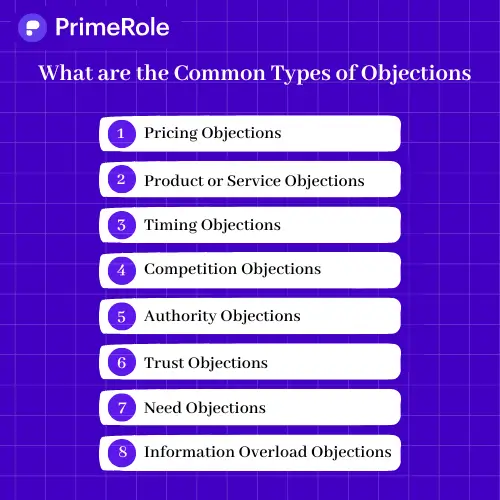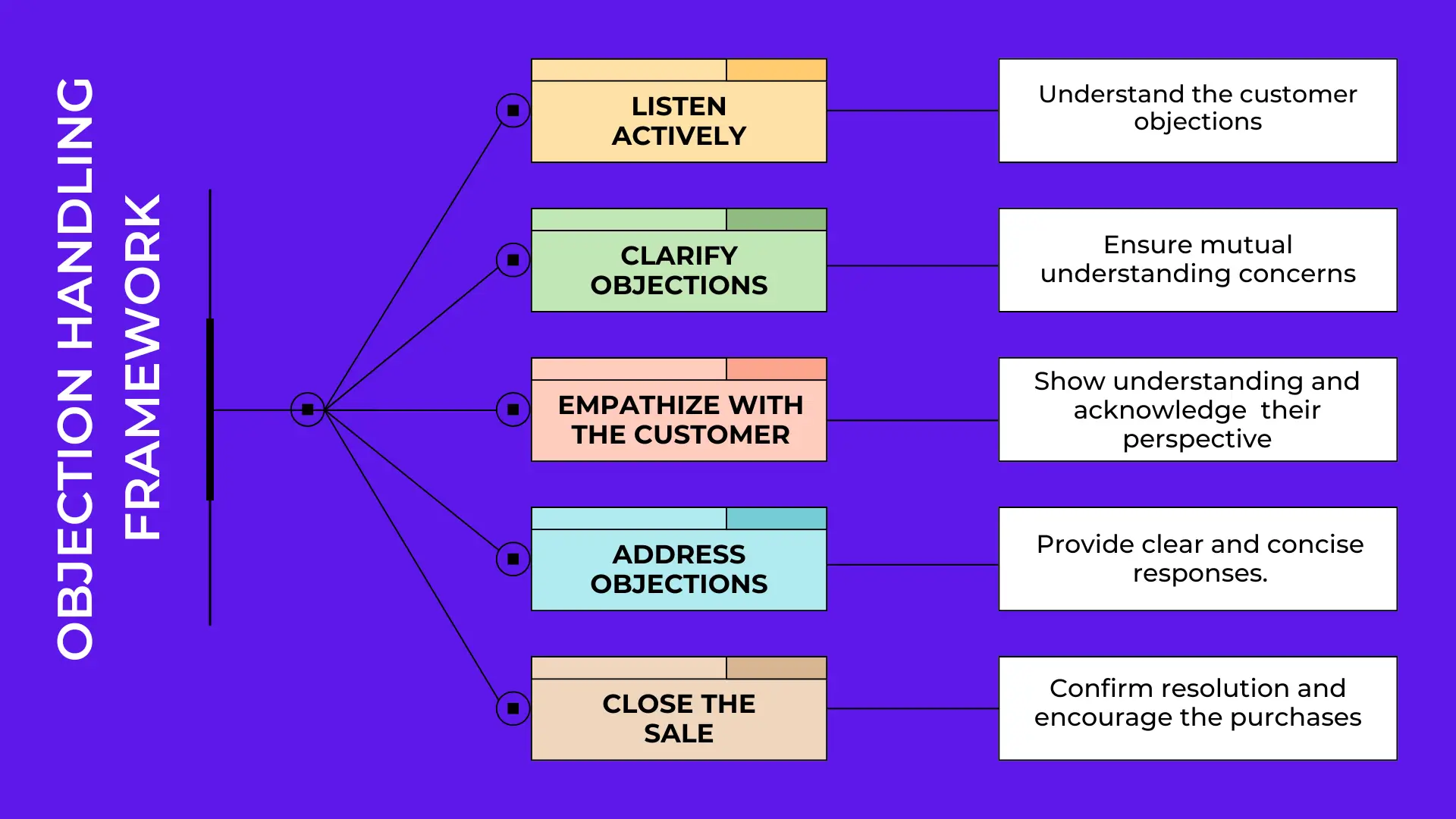
Sales professionals often encounter various challenges when engaging with potential customers, and adeptly addressing these concerns can make the difference between closing a deal and losing a prospect. Understanding and learning objection handling not only builds trust but also demonstrates a salesperson's commitment to meeting customer needs.
A significant insight into sales follow-up behavior highlights the importance of persistence. According to a study by Brevet, 80% of sales require an average of five follow-ups to close the deal. However, 44% of sales reps follow up with a prospect only once before giving up. This disparity underscores the necessity for sales professionals to remain diligent and proactive in their follow-up efforts, ensuring they address any objections or concerns that may arise during the sales process.
Table of Contents:
- What is Objection Handling?
- Why is Objection Handling Essential for Sales?
- Why Do Customers Raise Objections?
- What are the Common Types of Objections?
- 6 Proven Steps of Objection Handling Framework
- Conclusion
- Objection Handling Frequently Ask Questions (FAQs)
What is Objection Handling?
Objection handling is the skill of navigating a prospect’s concerns and turning hesitation into opportunity. Effective sales professionals understand that objections aren’t just roadblocks; they’re valuable insights into what’s holding a prospect back.
By addressing these concerns thoughtfully, salespeople can refine their approach and provide solutions that align with the prospect’s needs.
Mastering objection handling means listening actively, responding with clarity, and reinforcing the value of your product or service in a way that builds trust and moves the conversation forward.
Why is Objection Handling Essential for Sales?
Objection handling is an essential part of the sales process. Without it, even the most polished sales pitch can fall flat. The prospect or customer will have doubts, and if you don’t address them effectively, you’re likely to lose the sale.
Here’s a straightforward breakdown of why objection handling in sales in important:
1. Boosts Conversion Rates
When you handle objections well, you reduce the prospect’s uncertainty. If you're unable to tackle their concerns, they may walk away thinking your product isn't right for them. Learning objection handling can turn doubts into confirmations, directly impacting your conversion rates. Ignoring objections or fumbling through responses doesn't just hurt your chances; it can kill a deal right then and there.
2. Strengthens Customer Relationships
If prospects feel you’re genuinely listening to their concerns rather than just trying to push a sale, they’re more likely to trust you. A strong connection can be the difference between one-time buyers and loyal customers. If you're dismissive or defensive, you'll alienate them. Building rapport means being empathetic and responsive, paving the way for future business opportunities.
3. Reduces Sales Cycle Length
A clunky objection handling process can drag out your sales cycle. When concerns linger or go unaddressed, prospects hesitate and delay their decisions. Instead, if you manage objections promptly and effectively, you can accelerate their decision-making process. The longer you take to address an objection, the higher the chance they'll lose interest or find a better deal elsewhere.
4. Increases Confidence in Representatives
Salespeople who are well-prepared to handle common objections can respond confidently rather than defensively. If you find yourself scrambling for answers in the moment, it may indicate a lack of preparation and could make you seem untrustworthy. Being confident in your responses encourages more persuasive interactions. If you don’t believe in what you’re saying, your prospect won’t either.
Reach Your Ideal Prospects with Precision
Utilize PrimeRole's advanced tools to identify, target, and engage your customers effortlessly.
Why Do Customers Raise Objections?
Objections arise when customers have doubts or are unsure about a product or service. These hesitations may be due to previous experiences or perceived risks around the purchase. At times, it has to do with budgetary limitations or a lack of clarity around the value proposition.
But whatever the reason, objections tend to come down to a lack of information. Deep diving into the cause of objections can help convert potential roadblocks into conversion opportunities. Knowing why customers voice common objections helps to strengthen their confidence while deflecting an objection. This aids in sealing the deal and enhances relationships with customers in the future.
What are the Common Types of Objections?
Sales objections are an inevitable part of the selling process. They are not necessarily rejections, but rather signals that a buyer needs more clarity, reassurance, or alignment before they can move forward. Understanding the types of objections helps sales professionals anticipate resistance and maintain control of the conversation.
Here are the eight most common types of objections you’ll encounter:

1. Pricing Objections
Pricing objections are among the most frequently encountered in sales. These arise when prospects or customers feel hesitant to hear the price of a product or service and the value they expect to receive. In some cases, the objection is based on budget constraints, while in others case, customer think price are not matches with actual value they are getting. These objections often signal that the customer doesn’t fully understand the return on investment or how the solution fits into their financial framework.
Response:
Start by reinforcing the value of your offering and tie it directly to the prospect’s goals.
Example:
“I completely understand your concern about cost. Many of our clients felt the same way initially, but they found that the ROI more than justified the investment. Let’s take a closer look at how this solution can save you time, reduce costs, or drive revenue in the long run.”
2. Product or Service Objections
Product or service objections are raised when a prospect or customer has doubts related to features, functionality, quality of product or services. This can include doubts about whether it will work as promised, whether it integrates with existing systems, or whether it addresses their specific use case.
Service-related objections arise when prospects have doubts about support, reliability, or company reputation. These objections arise when customer are not familiar or have had a bad experience with a similar product.
Response:
Clarify how the product meets their specific needs, and use case studies or testimonials to build credibility.
Example:
“That’s a great question. Can I ask what specific concerns you have? We’ve helped similar companies who had the same doubts. Let me show you how they implemented our solution and the results they achieved.”
3. Timing Objections
Timing objections occur when a customer feels that now is not the right moment to make a decision or commitment. That might be based on internal prioritization, budget planning cycles, current projects, or external market conditions. Prospects may understand the values of the offer but want to delay their decision because of perceived risk, lack of urgency, or competing initiatives. These objections are usually more about internal timing than about the offering itself.
Response:
Understand their current priorities, and highlight what they risk by waiting.
Example:
“I get that timing is important. But if we wait, you could be missing out on [specific benefit]. Is there something coming up that we can align this with to make the transition smoother?”
4. Competition Objections
Competition objections arise when a prospect begins to compare your offering versus other options in the market. They might refer to other vendors with more features, more competitive pricing, longer tracks records, or more favorable conditions. This type of objection often stems from confusion in the buying process, conflicting information, or a stronger perceived fit with a competitor. It’s also common when your prospect is already using a competitor and is hesitant to make a change.
Response:
Respect their evaluation process and differentiate your offering by focusing on unique value.
Example:
“That’s great—you should absolutely explore all your options. Out of curiosity, what stood out about the other vendor? I’d love to share a few things that our clients say make us different and why they chose us over alternatives.”
5. Authority Objections
Authority objections arise when the person you’re speaking with does not have the power to make a final decision. This could mean they need to consult a manager, committee, or another department before moving forward. Sometimes the objection is genuine, and other times it’s a way to create distance in the conversation. In either case, this objection indicates that the deal cannot move forward without additional stakeholder involvement.
Response:
Identify all stakeholders early and offer to assist with internal alignment.
Example:
“Totally understand. Would it be helpful if I joined you in that conversation or provided a quick summary you can share with your team? That way, we can address any questions they might have directly.”
6. Trust Objections
Trust objections are rooted in skepticism, either about the salesperson, the company, or the product itself. This often occurs when dealing with newer brands, unfamiliar industries, or when prospects have had bad past experiences. Even if the offer looks good on paper, hesitation will remain if the buyer doesn’t feel confident in the people behind it. Trust needs to be earned, especially in high-ticket or long-term commitments.
Response:
Establish credibility through third-party validation, social proof, and transparency.
Example:
“I appreciate your honesty. We’re proud to have worked with companies like [Client Name], and I’d be happy to connect you with one of them. Also, here’s a bit more about our track record and support structure.”
7. Need Objections
Need objections occur when the prospect doesn’t recognize a problem that needs solving or doesn’t see how the solution applies to them. They may believe their current setup is working fine or feel that the issue you’re addressing is not relevant to their priorities. These objections are often a reflection of a gap in understanding or a lack of awareness about hidden inefficiencies or opportunities for improvement.
Response:
Reframe the conversation around pain points or missed opportunities.
Example:
“I hear you. Can I ask a couple of quick questions to make sure you’re not missing out on an opportunity to [save money/improve efficiency/etc.]? Sometimes, we uncover things that haven’t been considered yet.”
8. Information Overload Objections
Information overload objections arise when a buyer is bombarded with too many details, technical jargon, or complex explanations. Instead of gaining clarity, they feel overwhelmed, which can lead to analysis paralysis. In many cases, the core message gets lost, and the buyer becomes confused or disengaged. This type of objection is common in industries with complex solutions or when the sales pitch lacks structure and focus.
Response:
Simplify the message and break it down into digestible parts.
Example:
“Thanks for letting me know. Let’s take a step back and focus on the most important part for you. What’s the one thing you’re most interested in solving? I can walk you through just that piece to start.”
Supercharge Your Sales with Actionable Insights!
Transform your sales growth with PrimeRole verified data and AI-enriched company insights
Proven Steps of Objection Handling Framework
Objections are an inevitable part of the sales process. Whether it's concerns about pricing, timing, or product fit, salespeople must be prepared to address resistance with confidence and clarity. That's where a well-structured Objection Handling Framework comes into play. It’s not just about having the right words; it’s about following the right process.
A strong objection handling process empowers sales professionals to turn objections into opportunities. By actively listening, understanding the root cause of resistance, and responding with value, sales reps can shift the conversation and build trust.
Here are some proven steps for the objection handling framework:

Listen Actively
Active listening allows sales professionals to fully understand the customer's objections. Listening carefully often reveals the true nature of the customer's concerns. Customers feel valued and respected when their objections are heard without interruption.
Effective listening sets the stage for a more informed and relevant response. By demonstrating that you're genuinely interested in understanding their perspective, you lay the foundation for a successful resolution.
Clarify Objections
Clarifying objections ensures that both parties have a mutual understanding of the concerns. Sales professionals should ask questions to confirm their interpretation of the objection. Clarification often involves summarizing the objection to confirm accuracy.
Addressing the correct objection helps avoid miscommunication and provides targeted solutions. By ensuring that you and the customer are on the same page, you can tailor your responses to address their specific needs.
Empathize with the Customer
By the time you’ve clarified the objection, you’ve likely uncovered the real reason behind their hesitation. Now, before you jump into solutions, pause for a second. This is the moment to show empathy.
A quick acknowledgment like “I totally get where you’re coming from” or “That makes perfect sense” can do wonders. It shows your prospect that you’re not just trying to push a product. You actually understand their perspective.
Empathy isn’t just about being nice. It helps lower their guard, makes them feel heard, and creates space for a smoother, more open conversation.
And when someone feels like you truly get them? They’re way more likely to hear what you have to say next.
Address Objections
Addressing objections involves providing clear and concise responses to customer concerns. Sales professionals should tailor their responses to directly resolve the specific objection. Effective objection handling often requires a balance of empathy and factual information.
Addressing objections often leads to increased trust and a stronger relationship with the customer. By providing thoughtful and relevant solutions, you build confidence and pave the way for a successful sale.
Close the Sale
Closing the sale involves confirming that all objections have been addressed satisfactorily. Sales professionals should reiterate the benefits and value of the offering. A confident and assertive closing often encourages customers to make a purchase decision.
Following up after overcoming objections ensures customer satisfaction and retention. By maintaining open lines of communication, you reinforce the relationship and build long-term loyalty.
Conclusion
Behind every objection is an opportunity to build trust, clarify value, and move the conversation forward. Great salespeople don’t push harder, they communicate smarter.
That’s where PrimeRole comes in.
PrimeRole is a B2B sales intelligence platform designed to give your team the edge. With real-time insights, verified contact data, and enriched company intelligence, your reps are always prepared to handle objections with confidence and precision. With AI-powered enrichment, verified contact data, and precise ICP matching, your team connects with the right prospects, not just more of them. Seamless CRM integration ensures every conversation is backed by clean, consistent data for smarter, faster selling.
It helps your team approach every objection with confidence, armed with the right data and insights to build trust, qualify leads, and close deals more effectively. Every challenge becomes a conversation, and every conversation becomes a new opportunity.
Lead Generation Frequently Ask questions (FAQs)
How to handle objections in sales?
To handle objections in sales, listen actively without interrupting, acknowledge the concern, and ask clarifying questions. Show empathy and validate their viewpoint. Then, address the objection with relevant information or solutions. Keep the tone calm, confident, and focused on building trust and value rather than pushing the sale.
What are the 5 steps for objection handling?
To handle objections effectively, listen attentively, acknowledge concerns calmly, and ask clarifying questions if needed. Then, offer a suitable solution or explanation. Finally, confirm the customer’s satisfaction and proceed with the sales process or next steps confidently and professionally.
What are the 7 methods for handling objections?
The seven methods include direct denial, indirect denial, compensation, boomerang, feel felt found, asking questions, and postponing. These techniques help address objections based on the situation. By asking clarifying questions, offering tailored solutions, and confirming satisfaction, sales professionals guide customers toward a confident buying decision and continue the sales process.
What are the 4 P's of objection handling?
The 4 P’s are: Pause, Probe, Paraphrase, and Provide. Pause to avoid reacting impulsively, probe to uncover the real concern, paraphrase to show understanding and confirm the objection, and provide a solution or reassurance that addresses the issue, helping move the conversation constructively toward a close.
